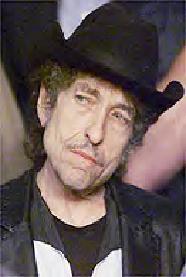|


BOBS BIOGRAPHY
|
 |
BiographyThe grandchild of Jewish-Russian immigrants,Dylan was born Robert Allen Zimmerman, on May 24, 1941, in Duluth, Minnesota, where his father, Abe, worked for the Standard Oil Company. In 1947, the Zimmerman family moved to the small town of Hibbing, where an unexceptional childhood did little to hint at the brilliance to
come. Robert started writing poems around the age of ten, and taught himself rudimentary piano and guitar in his early teens.Falling under the spell of Elvis Presley, Jerry Lee Lewis, and other early rock stars,he started forming his own bands, including the Golden Chords and Elston Gunn and His Rock Boppers. According to the 1959 Hibbing high school yearbook, his goal was "to join Little Richard." The young Zimmerman left Hibbing for Minneapolis and the University of Minnesota in the fall of 1959. The sights and sounds of the big city opened new vistas for him, and he began to trace contemporary rock and roll back to its roots, listening to the work of country, rock, and folk pioneers like Hank Williams, Robert Johnson, and Woody Guthrie.The following year, he dropped out of college and went to New York with two things on his mind: to become a part of Greenwich Village's burgeoning folk-music scene, and to meet Guthrie, who was hospitalized in New Jersey with a rare, hereditary disease of the nervous system. He succeeded on both counts, becoming a fixture in the Village's folk clubs and coffee houses and at Guthrie's hospital bedside, where he would perform the folk legend's own songs for an audience of one. Spending all of his spare time in the company of other musicians, Dylan amazed them with his ability to learn songs perfectly after hearing them only once. He also began writing songs at a remarkable pace, including a tribute to his hero entitled "Song to Woody."Indeed, his interest in music had become so intense that he rarely found the time to go to class. He began to perform solo at local nightspots like the Ten O'Clock Scholar cafe and St. Paul's Purple Onion Pizza Parlor, honing his guitar and harmonica work and developing the expressive nasal voice that would become the nucleus of his trademark sound. It was around this time, too, that he adopted the stage name Bob Dylan, presumably in honor of the late Welsh poet Dylan Thomas, though this is an origin he has continued to deny throughout his career.In the fall of 1961, Dylan's legend began to spread beyond folk circles and into the world at large after critic Robert Shelton saw him perform at Gerde's Folk City and raved in the New York Times that he was "bursting at the seams with talent." A month later, Columbia Records executive John Hammond signed Dylan to a recording contract, and the young singer songwriter began selecting material for his eponymous debut album. Not yet fully confident in his own songwriting abilities, he cut only two original numbers, rounding out the collection with traditional folk tunes and songs by blues singers like Blind Lemon Jefferson and Bukka White. The result (released early in 1962) was an often haunting, death-obsessed record that, culminating in Dylan's gravel-voiced reading of "See That My Grave Is Kept Clean," sounded as much like the work of an aging black blues man as a twenty-one-year-old Jewish folksinger from Minnesota.
Promising as that first album was, it didn't prepare anyone for the masterpiece that came next. The Freewheelin' Bob Dylan, released in 1963, contained two of the sixties' most durable folk anthems, "Blowin' in the Wind" and "A Hard Rain's A-Gonna Fall," the breathtaking ballads "Girl From the North Country" and "Don't Think Twice, It's All Right," and nine other originals that marked the emergence of the most distinctive and poetic voice in the history of American popular music. Cementing his reputation was Peter, Paul, and Mary's folksy cover of "Blowin' in the Wind," which went to No. 2 on the pop singles chart.
Promising as that first album was, it didn't prepare anyone for the masterpiece that came next. The Freewheelin' Bob Dylan, released in 1963, contained two of the sixties' most durable folk anthems, "Blowin' in the Wind" and "A Hard Rain's A-Gonna Fall," the breathtaking ballads "Girl From the North Country" and "Don't Think Twice, It's All Right," and nine other originals that marked the emergence of the most distinctive and poetic voice in the history of American popular music. Cementing his reputation was Peter, Paul, and Mary's folksy cover of "Blowin' in the Wind," which went to No. 2 on the pop singles chart Dylan's next album, The Times They Are A-Changin', provided more of the same: the title cut and "The Lonesome Death of Hattie Carroll" were the standout protest songs, while "Boots of Spanish Leather" was his saddest and most graceful love song so far. At the same time, Dylan seemed to be tiring of his position at the forefront of the protest movement: in "Restless Farewell," the record's last song, he concluded that he'd "bid farewell and not give a damn." Sure enough, his next album, pointedly titled Another Side of Bob Dylan, was his most introspective and least topical to date, and its finale, "It Ain't Me Babe," was an even more explicit goodbye to the folk movement he had helped reinvigorate.
|
|
|
|
|
|
|
|
|
|
|
|
|